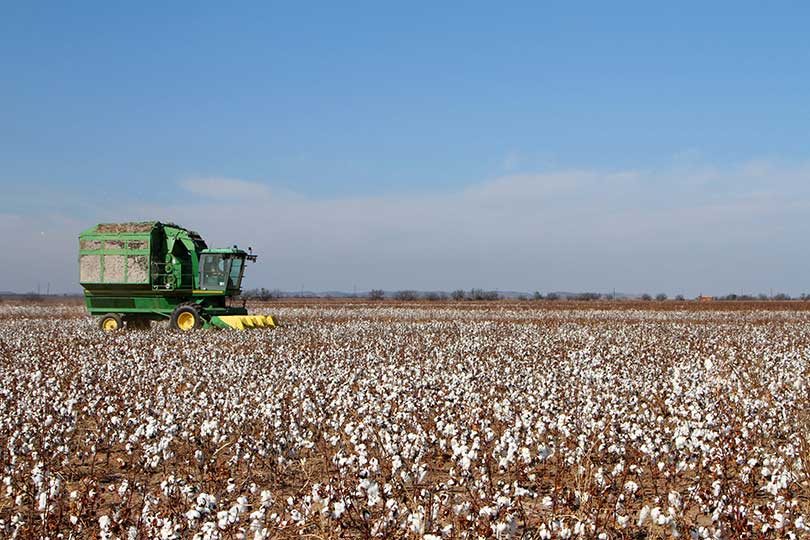According to the U.S. Department of Agriculture (USDA) World Agricultural Supply and Demand Estimates (WASDE) report, the 2017-18 cotton crop could reach 19.2 million bales.
USDA’s May 10 WASDE report estimate of 19.2 million bales would mean the 2017-18 cotton crop would be the largest in more than a decade. In 2006, U.S. growers harvested 21.6 million bales of cotton on 12.8 million acres, according to Southwest Farm Press.
The agency also increased its export forecast for the 2016-17 marketing year to 14.5 million bales. USDA economists said the new number reflected higher-than-anticipated export sales to date.
“Production is anticipated to rise 12 percent from 2016-17, based on 12.2 million planted acres as indicated in the [March 31] Prospective Plantings Report, combined with below average abandonment—due to relatively favorable moisture—and average yields,” the economists said in the WASDE report.
The marketing year average price received by growers could range from 54.0 to 74.0 cents per pound, according to the World Agricultural Outlook Board economists. Some technical analysts say cotton futures could still climb to 84 cents a pound this year.
The WASDE report indicated world cotton stocks are continuing to decline after reaching unprecedented levels while China placed millions of bales of excess cotton in its strategic reserve beginning in 2011.
“The world 2017-18 cotton projections show a decline in stocks of 2.4 million bales, as consumption exceeds production for the third consecutive season,” the report said. “Global production is expected to rise nearly seven percent, despite marginally lower average yields, as area rebounds to its highest level in three years.”
Led by the United States at 2 million bales higher, production is forecast to rise in all major producing countries. Global consumption is projected to rise 2.3 percent, as a growing world economy drives mill use higher around the world.
“Projected world trade is also raised slightly from 2016-17, as import-oriented consumers such as Vietnam and Bangladesh are accounting for a larger share of world consumption,” USDA economists said. “Ending stocks are projected at 87.1 million bales, 75 percent of world consumption.
Cotton across the state of Texas appears to be in good shape, according to crop reports from AgFax Southwest Cotton.
Cotton in the Texas Panhandle is off to a good start, according to Texas A&M AgriLife Extension Cotton Specialist Seth Byrd in Lubbock.
Planting in Frio County, south of San Antonio, is complete, according to Jaime Lopez, Texas A&M AgriLife Extension agent.
“I drove around our cotton fields late last week and everything looked pretty clean, with no major weed outbreaks,” Lopez said. “I’m hearing no reports of thrips thus far.”
Lopez said all of the crops in the area could use moisture.
Cotton planting in the Southern Plains is rolling as soil temperatures warm up, according to Jourdan Bell, Texas A&M AgriLife Extension agronomist, Amarillo.
“In the northern Panhandle, a lot of cotton is going into no-till ground,” Bell said. “Farmers are doing a good job of managing cover crops and residue to help minimize evaporation losses.”
Bell also said fields in the region are mostly clean of any weed pressure.
“Overall, it’s exciting to hear of the large amount of cotton to be planted in this region,” Bell said.
Cotton is starting to bloom and the crop looks good in the Coastal Bend region, according to Gaylon Morgan, Texas A&M AgriLife state cotton specialist, College Station.
“In the Brazos Bottom, fields are progressing and some guys started irrigating last week,” Morgan said.
Morgan had not heard of any major pest problems in the area.
“The Waco area caught a little rain and some minimal hail damage,” Morgan said. “Cotton has been growing a little slow due to cooler temps.”
Some cotton in the Lower Rio Grande Valley is blooming, while other fields are at a pinhead square, according to Danielle Sekula Ortiz, Texas A&M AgriLife IPM agent.
Control efforts have helped push back strong aphid numbers in the region. Growers in that region have also been dealing with a flare-up of fleahopper pressure.
“We’ve been spraying for them and could see more numbers after guys start harvesting sorghum,

